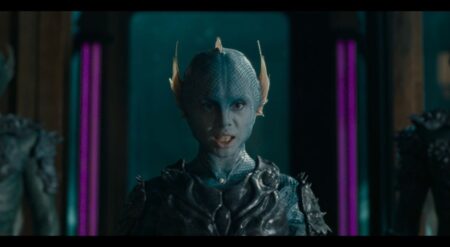Netflix Original sci-fi series Tokyo Override, animated by RiFF Studio, explores a futuristic Tokyo optimized so its citizens can enjoy true freedom. However, this freedom is only surface-level and only for specific individuals. When the teenage Kai (Ai Fairouz, Kakeguri Twin) falls into the world below the surface of Tokyo’s liberty, she quickly begins to see the many cracks in the system as she helps the Suma Garage aid those the system ignores.
We are all used to the gritty, dystopian future setting. The ones filled with neon signs and body augmentations warning of technological addictions and manipulations that rob humanity of its freedoms by mega-corps. The cyberpunk genre is built on these themes, after all. Rather than tread down this familiar path to deliver its vision of a future oversaturated with insidiously controlling technology, Tokyo Override presents a pristine, clean world that one can believe a populace could happily accept even though their unfettered freedoms are quickly revealed to be made of empty promises.
The world presented in the series’ six episodes is one centered around tags. Everyone has a tag, and the government uses the tags to collect data and control every city element. Everything from maintaining the traffic, primarily automated cars, to social services is managed by the data collection of tags. Tagless people are treated as a non-entity and kicked out of the city.
Tokyo Override does a fantastic job of presenting the world in a way that makes it easy to see why the average person would allow, or even welcome, this level of control. Everything looks clean and pristine as average people enjoy their near pollution-free world. Only once Kai begins to confront society’s many shortcomings does the viewer see through the veneer of “perfect optimization” that the city’s controllers constantly brag about.
The heroes Kai falls in with are a group of couriers who aid those overlooked by the city’s optimization efforts. The group handles everything from helping the tagless escape deportation to ensuring vital resources reach those the system overlooks through skillful hacking and stylish motorcycle driving.
The driving sequences are the highlights of Tokyo Override. The layout of these sequences is very creative. In these moments, the heroes’ tricks and the automated pursuers’ design come together to deliver some original chase sequences that engage the viewer. These moments are also where the series’ animation style shines the brightest.

The CGI animation that brings the world of future Tokyo to life delivers ample style to the heavily digital setting. Hacking sequences are handled wonderfully, as the interfaces and holograms that present these elements are filled with vibrant colors and cool effects.
The animation is also at its smoothest during the several chase sequences as the swerving bikes and high-flying jumps are presented with skillful planning and augmented with splashes of color that keep the action of these sequences popping through the show. With how well these complex sequences play out, it is surprising how rough simpler moments sometimes feel.
There are moments when character animations feel inconsistent in their fluidity. These moments create an almost stop-motion feeling, which could work if it felt intentional. However, the intermittent nature of these moments distracts the viewer and creates a jarring effect on the visual presentation.
Tokyo Override‘s narrative is a solid game of cat and mouse. While there are moments of genuine threat, Tokyo Override often fails to sell the danger the heroes face. The stylish chases are fun but rarely thrilling, as failure always feels impossible. A remarkable narrative twist significantly alters the threat the characters face in the back half of the season. The twist is easily the story’s highlight as it is well-disguised and dramatically shifts the group’s immediate objectives.
The most head-scratching element of the series’ story is the amount of time it’s willing to waste. A sizable portion of an episode is dedicated to a motorcycle racer with little to do with the show. While a couple of elements about how the city functions are introduced in this portion of Tokyo Override, it doesn’t need to waste all the time it does to explain these systems to the viewer. It could make sense in a more extended series, but the time could’ve been spent in much better ways with only six episodes. The biggest of these would be fleshing out the characters who matter.
Most of the characters in Tokyo Override are no more than two-dimensional cutouts. You have the jokester, the serious one, and the guy always looking to inspire those around him with corny lines about heart and heroism. The only character that viewers ever really connect with is Kai. As the tale’s central personality, Kai gets enough screen time to feel like a fully realized person. We get enough of her backstory and inner feelings to understand and sympathize with her.
Despite its shortcomings, Tokyo Override is a fun story with enough style and uniqueness to justify the roughly three hours it takes to watch. Far from a must-watch, it does provide sci-fi fans with some original concepts that entertain.
Tokyo Override is streaming now on Netflix.
Tokyo Override
-
Rating - 6/106/10
TL;DR
Despite its shortcomings, Tokyo Override is a fun story with enough style and uniqueness to justify the roughly three hours it takes to watch.








